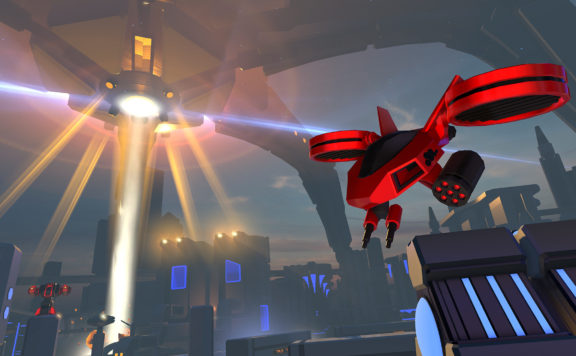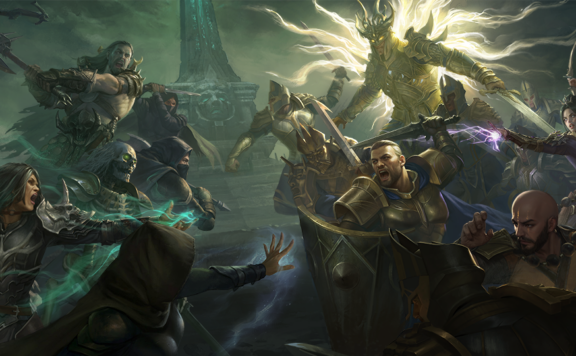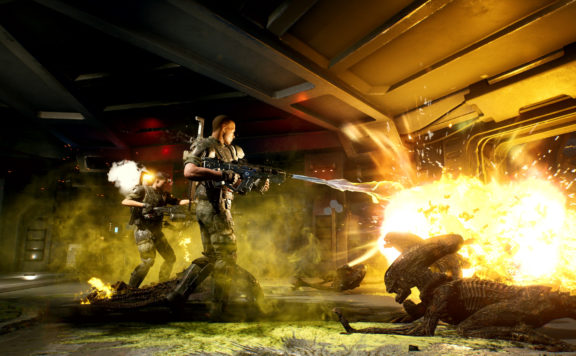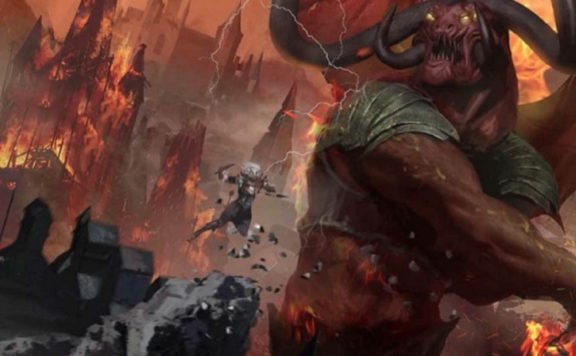A while back I was able to jump into the beta of The Bard’s Tale 4: Barrows Deep and get a first impression of inXile’s newest reincarnation of an old school game. I liked what I saw during my play time, so I’ve been patiently waiting to get my hands on the full release. Full disclosure, I was a huge fan of the original series so my time with the beta was definitely viewed with rose-colored glasses. Nostalgia can be a double-edged sword though, and even the best of memories can only take you so far if the new experience doesn’t live up to the hype you have built up around it. Find out below if The Bard’s Tale 4 continues to wield the magic that was first seen thirty years ago, or if it fails its saving throw and succumbs to the Trap of Expectations. This is our Bard’s Tale 4: Barrows Deep review.
The Story As We Know It
For anyone wondering if they need to jump into a time machine and play the original series to understand what is going on, don’t fret, as The Bard’s Tale 4 doesn’t require any previous experience with the franchise. The setting is still the same, the god-forsaken town of Skara Brae and its surrounding areas, but we begin our new adventures one hundred years removed from the trilogy’s events, and the trials and tribulations of the original heroes are nothing more than tales of legend. At the same time, inXile has done a good job of catering to veterans of Caith. This isn’t a reboot of the original Bard’s Tale, but a continuation of the story, with plenty of easter eggs that will bring smiles to a bunch of middle-aged faces.
Simply put, Skara Brae is an evil magnet. Time and again a powerful evil-doer has made Skara Brae their home, only to have a group of adventurers rise to the occasion and save the land of Caith from their tyranny. This time around a group of cultists, the Fatherites, has infested the town and has begun killing members of the Adventurers Guild. Naturally, your name finds its way onto their bad list; fortunately, you have the bard Rabbie to guide you to safety. This is where the old meets the new, as Rabbie helps you escape to Skara Brae Below (the new town has been rebuilt upon the town destroyed in BT3), and you set up a base of operations in the old Adventurers Guild. It is up to you to then head out and save the town from the Fatherites, building up a party of hearty adventurers as you go.
We all know that it’s never that simple. In true high fantasy fashion, you will quickly realize the Fatherites are merely a tool being used by the real evil hidden behind the curtain. It is up to you to follow the bread crumbs in this fairly linear story, scouring the many dungeons scattered around the area, dispatching one denizen after another. If you have the fortitude to persevere, you will get the chance to save the world and your name will be sung by bards for ages to come.
Party Up
For those of you just tuning in, The Bard’s Tale 4 is a party based first-person dungeon crawler. You start off as a solitary adventurer, but as you progress through the story you will enlist the help of other brave souls. These characters are pre-created, but you are able to swap them out for made from scratch mercenaries. There are certain points throughout the story requiring a specific character be in the party but, for the most part, you are able to mix and match premade and handcrafted adventurers in any configuration you wish, with the other adventurers, patiently waiting for you to call on their services. After completing the tutorial, you will have but two active party members, with a total of six slots, eventually being unlocked.
One of the tenets of the original Bard’s Tale games was the flexibility in party makeup. This holds true in BT4. With only four classes available to choose from (Fighter, Practitioner, Rogue, and of course Bard), at first glance the character creation seems rather simple, but the complexity is revealed as your characters progress in level. Each class has four or five skill trees. All classes have an attack, a defense, and a crafting tree along with a class-specific tree. For example, the Fighter has access to the Command tree while the Rogue gets all of their sneaky bits in the Subterfuge tree. The Practitioner is special, getting access to two trees, the Meditation and Bladecasting tree. The Bard provides group support through its Music tree and replaces the regular crafting tree with Brewing to get additional crafting options the other classes can’t access. While all the class-specific skills definitely define each character’s traditional role in the group, there is enough variety to ensure each class has multiple builds.
Another element found within the original series was the sub-classes, and again, BT4 follow suit. Buried deep within some of the skill trees is the BT4 take on sub-classes. Unlike the minor skills in a tree, selecting the sub-class skill bestows a combination of stat increases, active/passive skills, and can even unlock new exotic weapons and armor options. Putting the sub-classes at the end of specific branches can feel restrictive, but it ensures you spend at least some of your points on skills that complement your chosen class. After all, nothing is worse than not being able to finish a game because you gimped your characters by making uneducated choices.
Rumble In The Brae
All of the choices you make during character progression and loot gathering really shine during the turn-based combat of BT4. Combat is played out on a 4 by 4 grid, with your party on the southern half of the grid and the enemy on the northern half. Instead of each party member making a single move or attack each round, your team is given a set amount of opportunity points to share. While some actions may be free, such as the fighter’s Taunt, most physical actions cost at least one opportunity point. As you grow in power you will have a larger opportunity pool to draw from, and there are even ways to recoup points during a round, effectively giving bonus actions to your party. A character is also able to perform multiple actions, or none at all, as long as they have an unused skill and the points to activate it. Don’t forget to use up all your points though, as unused points don’t carry over to your next round.
Spellcasters also have spell points to use. Just like opportunity points, casters will have a finite amount of points to use each turn. Spell point pools are character specific, and any unused spell points will carry over to the next round, up to your character’s maximum allowed. Great power requires concentration, so it may take a few turns to build up the points necessary to unleash maximum fury on your foes. Just make sure you keep your caster alive long enough to get the spell off.
Your opponent also follows these same rules, so combat can become a game of cat and mouse. While some attacks like shooting arrows can reach any spot on the grid, many attacks are limited in reach. This makes movement, or the limiting of it, an integral part of combat strategy. A lightly armored mage on the front row is easy pickings, and an ultra-powerful attack with a short range may be useless if you aren’t in the proper position to hit the correct foe.
It’s A Trap!
The last carryover from the original series I want to highlight is the dungeon crawling itself. Just like every other game of the genre thirty years ago, The Bard’s Tale series had a grid-based system. When you moved forward, you moved exactly one block. When you turned, you turned exactly 90 degrees. Fortunately, BT4 left that system in the ashes of old Skara Brae. inXile chose to bring BT4 to life within the Unreal 4 engine. That means we get the free range camera and fluid movement of any modern first-person game, at least outside of combat. That is obviously a huge improvement over the old grid movement, but it does come with a downside – solving puzzles and avoiding traps.
A core piece of dungeon exploration is solving puzzles and avoiding traps, and there are a LOT of both to be found within many of the mazes you will be running through. The puzzles are not overly simple, but most aren’t too hard either. There are even some places that finding a secret passage would allow you to avoid a puzzle or trap altogether. I still went back and completed the puzzles, just because that’s how I am.
The issue I ran into was being able to detect the minor pattern variations in things like secret walls, or even just running right past a button that needed to be pressed because I was looking in the wrong direction. And for me, once I missed it, it would take me forever to find it. The harder I looked, the harder it became to find. This may never happen to some players, but I thought it was worth mentioning as it could be frustrating to some. It isn’t anything that can be fixed short of highlighting objects, which defeats the purpose of having them hard to find in the first place. It’s just an unfortunate side effect of switching from a system that has very restricted movement to one that gives you unlimited freedom.
Nostalgia Off
As I said at the beginning of the review, nostalgia can be a double-edged sword, and for The Bards Tale 4: Barrows Deep, it does cut both ways. While the story is good, character development was complex, and the turn-based combat was fun and rewarding, the whole time I was playing there was one thing continually causing the rose-colored glasses to crack: the technical issues.
First and foremost are the graphics. They are just all over the place. Even on ultra settings a lot of the textures just looked blurry. And at ultra the frame rate was terrible. There were times that the frame rate would dip into the teens, and rarely did it go above 30fps. Reducing the settings or lowering the resolution did a little to help on the fps side, but it wasn’t worth the further degradation of the textures. The other major issue was crashing to the desktop. These would randomly occur, and there is nothing worse than losing 20-30 minutes of progress to the one trap that you can’t avoid.
The resolution issues have already been acknowledged by inXile, with patches already in the works to fix some known bugs that are expected to make an improvement on this front. The last patch released already reduced the number of crashes, so hopefully, they will continue to improve in that area as well. It is a shame to have a game that was so much fun to play be brought down a couple of notches due to technical issues.











